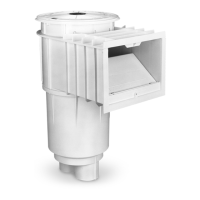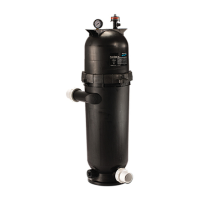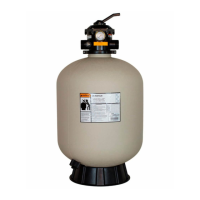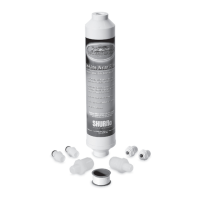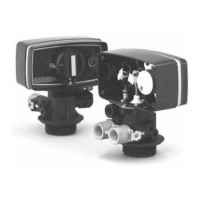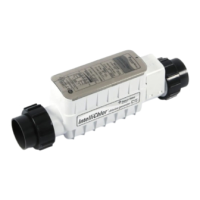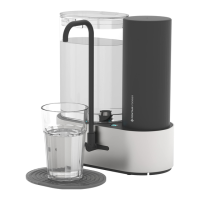17
English
SC-75™ Salt Chlorinator Usage Hours Meter
The SC-75 provides a built-in cell “usage hours” meter that reports how many hours SC-75 has been operang.
To access the system status mode:
1. Press and hold the MORE buon for three (3) seconds unl the lights scroll across the unit.
2. One (1) of the three (3) Sanizer Output LED indicators (Low, Med, High) will be lit, indicang the hours of usage. The
Output LEDs are as follows:
• 2000 hours (Low LED on)
• 4000 hours (Med LED on
• 6000 hours (High LED on)
Cleaning the SC-75 Cell Blades
Note: Before acid washing, remove the calcium buildup in cell: Use a garden hose on the jet seng and spray directly into
both ends of the cell. Most of this calcium buildup has a slushy consistency and will be blown out of the cell. Once the
majority of the calcium has been removed, connue with acid washing which will now be more eecve since most of the
calcium has been removed.
1. Automac Cleaning: The SC-75 has an automac cell blade cleaning feature (cell reversing) that helps remove scale
deposits from the SC-75 blades. Note: Automac cleaning does not interrupt chlorine producon. “Scale” is a white crusty
deposit that forms in excessively hard water or from pool water that is out of balance and in a scaling condion. If the SC-75
blades show excessive scaling, you need to perform an acid wash cleaning. Proceed to “Acid Wash Cleaning” Step 2.
2. Acid Wash Cleaning: If the SC-75 blades show a tendency to scale, it is recommended that every two (2) months the
SC-75 be removed and inspected for scale formaon and/or debris on the SC-75 blades. High hardness areas may require
more frequent cleaning. Some lters allow debris to pass through to the SC-75, possibly lodging between the blades in the
SC-75. A small amount of scale formaon is normal. If by looking through the SC-75, it is observed that there is excessive
scale formaon between the blades, or debris is present, the SC-75 must be cleaned as follows:
Use a high-pressure jet of water from a garden hose. If the blades cannot be reasonably cleaned in this manner,
acid cleaning is necessary.
TO ACID CLEAN THE SC-75™ BLADES:
1. Disconnect the AC power from the Power Center. Disconnect the SC-75 Salt Chlorinator cell communicaon cable from
the Power Center.
2. Mix one (1) part acid with one (1) part tap water in a plasc bucket.
3. Submerge the blades in this soluon without allowing the control panel or cables to be exposed to the soluon
4. Allow the acid soluon to bubble, and to clean the blades.
The acid should only be contained inside the SC-75 covering the blades. Try not to spill the acid on the outside of the SC-75.
If acid does spill on the outside of the SC-75, wash it o with water. A foaming acon will begin, which is caused by scale
(calcium carbonate) being dissolved from the blades. If rigorous foaming acon does not begin, the blades do not need to
be cleaned (STOP THE CLEANING PROCESS - go on to the next step). Otherwise, allow the blades to remain immersed in the
soluon unl the foaming has stopped. However, do not leave acid in the SC-75 for more than thirty (30) minutes. Excessive
acid washing will damage the blades.
5. Remove the SC-75 from the bucket and place in an empty 20 liter bucket. Rinse the inside and outside of the SC-75
thoroughly with clean tap water and inspect. If deposits are sll visible, repeat the acid cleaning process.
6. Rinse the SC-75 again with clean tap water and inspect. Once clean, replace the SC-75 and resume normal operaon.
7. If the acid wash procedure is necessary, it is recommended that a sample of pool water be analyzed by a pool professional
for excessive calcium hardness (i.e. ideal range is 200 to 400 ppm) and/or improper water balance.
8. Inspect the inside of the SC-75 every two (2) months (or more frequent in hard water areas). If no scale or debris deposits
are observed inside the SC-75 aer four (4) months, it is not necessary to connue inspecons every two (2) months. However,
due to possible changes in pool water chemistry and ltering eecveness, it is recommended that the cell be removed for
inspecon at least twice a year.
9. Reconnect the SC-75 communicaon cable plug in the Power Center, then reconnect AC power to the Power Center.
Winterizing
Very lile chlorine producon is needed in cold water so long as free chlorine levels are maintained at 2.0 - 4.0 ppm. The
SC-75 Salt Chlorinator will not produce chlorine below 12° C. This low-temperature cuto extends the life of the cell. If
preventave measures are not taken, freezing water may cause severe damage to the cell. Prevent freeze damage to the cell
by running the pool pump connuously or winterize the pool by draining water from pump, lter and all intake and return
lines. Remove the cell, clean and store it.

